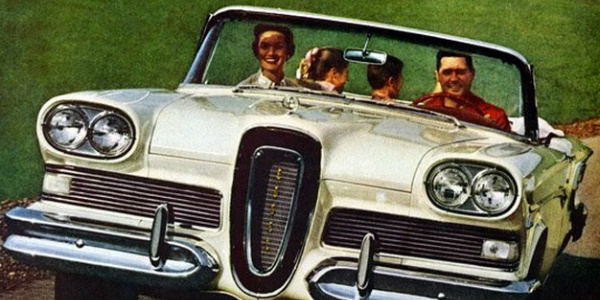Don’t drink the Kool-Aid

The phrase, “Drinking the Kool-Aid” is often used when a financial institution is so attached to its own products and services that if fails to consider the needs of its customers or the media. I have worked with financial institutions whose belief in their own offerings and philosophies made them blind to the real world, and worse yet, wound up offending the various stakeholders upon whom their success and failure depends.
“Drinking the Kool-Aid” is not the same thing as “team spirit.” Passion for one’s organizational vision and mission is a wonderful thing. I’m talking about the C-suite executives who forget their bank or credit union is there to fulfill an unmet need that their audience actually wants.
Consider the Ford Edsel story. The “Edsel” has gone down in history as a colossal marketing faux pas, or failure to gauge what their customers wanted. There are several reasons for its failure:
The Edsel was designed by a very large committee. Time magazine called it, “irrational groupthink.” The Edsel designers were focused on designing a vehicle for a segment whose needs had already been met. They called it, “Edsel,” which didn’t help either.
They misinterpreted the research. The Ford Company spent thousands of dollars on market research. What they didn’t know then was that people tend to lie on surveys, telling researchers what they think others, not themselves, want. Some argue that the survey data was viable, but Ford’s interpretation of it was incorrect.
The car was, well, ugly, and had many mechanical flaws. The assembly lines had trouble putting it together. There were complaints about the taillights. The worst feedback of all, however, was about the appearance of the front grille. One of the nicer insults was that it looked like “an Oldsmobile sucking a lemon,” and there were other snarky anatomical references.
Consider Ford’s mistakes when planning your next story pitch to the media.
1. Take your head out of the sand. The media and your target audience are hungry for interesting stories, educational content and how your particular products and services solve problems. Find ways to provide information, products and services that meet the topical interests of the media, not the fiscal need of your organization. In other words, consider the interests of the media outlet you want to pitch rather than push a story that meets your agenda alone.
2. Target the media who are interested in your industry. One of my editor friends vented the other day at lunch. She covers women’s issues and wellness, but daily in her email inbox she gets press releases and pitches about animals, auto racing, food and other unrelated topics. She said she used to forward the releases to the appropriate news desks, but lately, she’s just deleting them. Before you send press releases or requests for coverage to any media outlet, do a bit of research first. Find out what they need to do their jobs. It will be appreciated and yield good karma.
3. Test your product or service thoroughly before rolling it out to the media. The press had a field day with the Edsel. It became the “fun thing to criticize.” If there’s any fault whatsoever with your product, how it’s delivered, or the quality of your customer service, there could be a storm of controversy in the form of customer complaints in social media or bad reviews from well-intentioned consumer advocacy reporters. Be sure your offering is a well-oiled machine with plenty of support from your friendly, well-trained employees.
The Edsel was dubbed, “the wrong car at the wrong time.” So, stay away from the Kool-Aid and take care of your stakeholders first.





